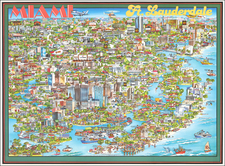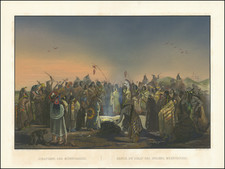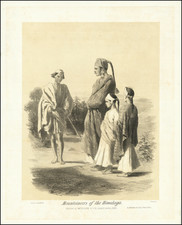The King of Florida
Scarce image of the "King of Florida" and several of his subjects with indigenous costumes.
The image appeared in Happel's Thesaurus Exoticorum, pubished in Hamburg in 1688. The text below reads:
Next to Virginia to the southwest, quite well formed and painted, lies the vast region of Florida, which is intersected by various rivers. Towards the sea, however, it is completely flat and sandy. Sebastian Cabot first discovered this region, which was then named Sacafa, but later called Florida by Ponce de Leon. Here the Spanish have built two fortresses; one at Cape Helene is dedicated to the Apostle Matthew, while the city and castle of Augustine are located on the River May. Before both the castle and the city lies a land, inward full of meadows and trees, but near the sea, it is hilly. A rather deep and wide river runs through the land into a large waterway, which the city and fortress overlook. The fortress is square, with a round tower on either side. Two streams, flowing from the land into the waterway between the mainland and the foreland, strongly fortify the castle. The city itself is quadrangular. However, it is more densely built towards the fortress and is divided into four streets. The church stands outside the city, and right in front of it is the Augustinian monastery.
On the inhabitants' appearance and their deliberations:
The inhabitants are olive-skinned, large-bodied, and within 24 hours [possibly some context missing here]. For modesty, they wear deer skin, and on their heads, a cap, intertwined at the bottom with feathers. Black hair hangs down to their shoulders, which they braid at the top like a tulip. On their chest hang two small shields, and six smaller ones around the arms, as well as two shells on each ear, and a quiver full of arrows, tipped with fish teeth, on the side. In their left hand, which is covered at the top with a rectangular copper plate, they carry a bow. Thus, they go to war, with the king leading with a club. Every day they gather to discuss war matters in the king's residence, where he sits on an elevated platform. The most prominent greet him first, placing their hands on their heads as they shout: ha/he/ha, after which the others shout ha/ha. As soon as this greeting occurs, they sit down in a circle. When an important matter arises, the king summons the elders and priests, whom they call Jawas. Then, a drink made from leaves, which they call Kashine, is presented to the king. When he has drunk it, the others also drink in turn from the same cup. This drink induces sweating and suppresses hunger and thirst for 24 hours.
Eberhard Werner Happel (1647–1690) was a German author of scientific and historical works. The son of a reformist Lutheran minister, he studied law, mathematics, and natural sciences in Marburg, Germany, from the 1660s to 1680s, though due to financial issues he never finished his formal education. He also tutored aristocratic families in Hessen and Hamburg during this time. Around 1680 he devoted himself to writing, publishing several works of historical fiction. He also published several historical and scientific almanacs, the most famous of which was Historia Moderna Europae, which covered recent European political history and included detailed maps and engravings. His most famous scientific work was Gröste Denkwürdigkeiten der Welt: Oder, So genannte “relationes curiosae”, which contained one of the most important early discussions of oceanographic phenomena. In later years Happel continued to be a successful and widely read author. He died in Hamburg at age 42, survived by his wife, Margarita, and four children.










![(Native Americans) Dacota Indianerin [Dacota or Crow Woman and Assiniboin or Blackfeet Girl]](https://storage.googleapis.com/raremaps/img/small/81196.jpg)
![(Mexican-Aztec Paintings) Facsimile, page 19 of an original [Mex]ican painting of Sir Thomas Bodley's collection [in the Bod]leian Library, Oxford, [Aglio's] Antiquities, vol. 1](https://storage.googleapis.com/raremaps/img/small/102328.jpg)


![[Uncaptioned image of two figures seated in front of a tipi, mounted albumen print]](https://storage.googleapis.com/raremaps/img/small/78744.jpg)